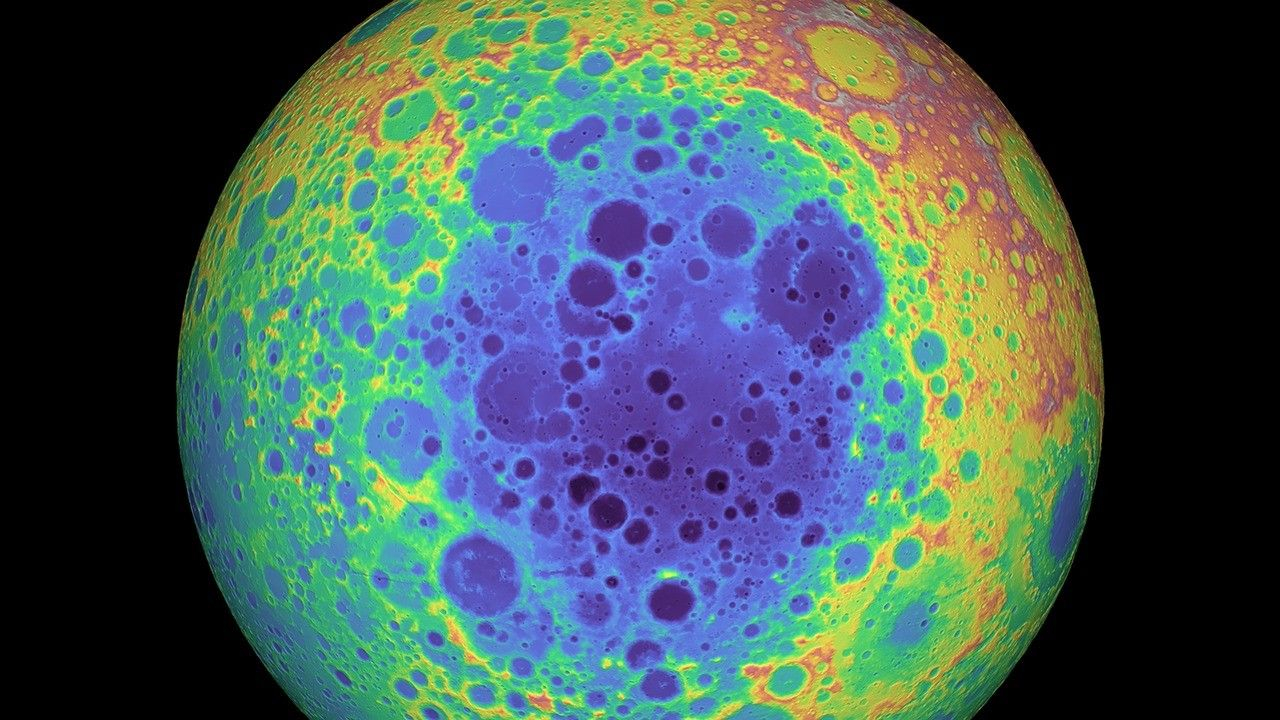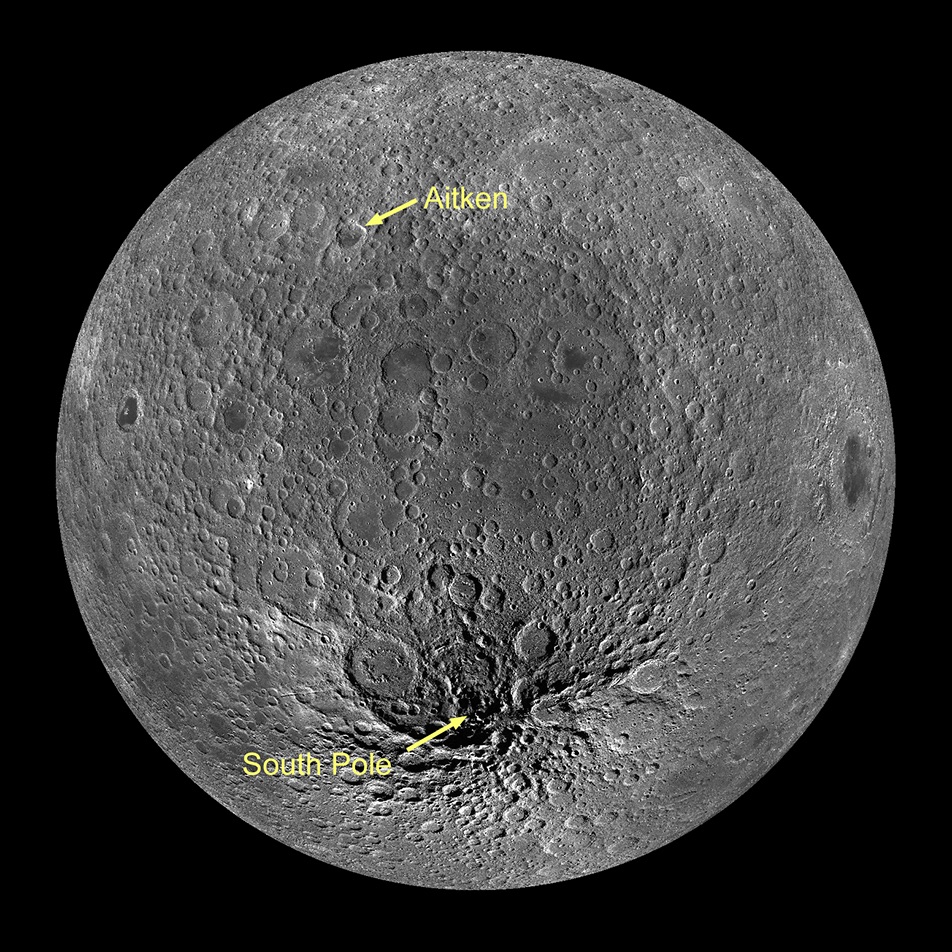A giant crater on the moon may hold remnants of an ancient magma ocean. Artemis astronauts could bring home samples of it
Material from the crater can "tell the story of the late evolution of the lunar magma ocean," scientists say.

A giant impact crater on the moon may contain primordial pieces of the lunar mantle and remnants of an ancient magma ocean, researchers say. Crewmembers on upcoming Artemis missions could potentially return samples from the young mantle back to Earth, providing insight into the final stages of lunar formation.
Roughly 4.3 billion years ago, a relatively large object slammed into the surface of the moon, gouging the crust to form the South Pole-Aitken (SPA) basin. Samples from this impact remain strewn across the lunar surface, providing a snapshot of what the mantle looked like while it was still crystallizing.
"We propose the South Pole-Aitken [impactor] excavated a thin, late-stage magma ocean," Jeff Andrews-Hanna, a planetary scientist at the University of Arizona, said in March at the annual Lunar and Planetary Science Conference in the Woodlands, Texas. "Artemis will sample SPA ejecta and possible magma ocean material."
The South Pole-Aitken basin has a very slight elongation, which suggests an oblique impact, rather than a head-on collision, from its parent collider. At its northern edge lies a pool of material, an excess of thick crust whose volume roughly matches the amount of missing crust from the basin. A northward-traveling impactor could have blown material from the crash northward, ahead of it.
But Andrews-Hanna and his colleagues decided to take a different approach to the basin. Instead of looking at possible interior material, they studied the shape and compared it with other teardrop-shaped craters on the moon. When a rocky body collides with the lunar surface at an angle, the resulting basin is elongated in the direction of the impact. Other elongated lunar craters taper in the direction the object was moving. SPA has a tapered shape, but it is to the south, not to the north — leading the researchers to conclude that the object was moving southward, not northward.
"We have had the data we needed to measure the shape of the basin for a long time," Andrews-Hanna said. "It just took a different perspective to view the basin this way."
Related: The far side of the moon was once a vast magma ocean, Chinese lunar lander confirms
Get the Space.com Newsletter
Breaking space news, the latest updates on rocket launches, skywatching events and more!

Separation of crust and mantle
When the solar system was young, a Mars-sized object crashed into the nascent Earth. The two protoplanets were blown apart and slowly recombined into two new objects — Earth and the moon — briefly liquefying both objects.
The molten mantle material slowly cooled and began to crystallize. A low-density mineral called plagioclase floated to the surface to form the crust, while denser materials sank to the interior. Andrews-Hanna called this the "smoking gun" for the existence of a magma ocean during the lunar formation process.
At the same time, some of the material — components such as potassium, rare earth elements and phosphorus, which are often referred to as KREEP (potassium (K), rare earth elements (REE), and phosphorus (P)) — didn't make it into crystals and instead began to concentrate in the melt.
Previous studies had already revealed the presence of thorium consistent with KREEP impact melt along the floor of the basin, suggesting that the mantle material may have broken through the crust during the impact. But no sign of mantle material has been spotted to the north.
When Andrews-Hanna and his colleagues reviewed the maps of the moon, they found that the southwest ejecta blanket carries a significant amount of thorium related to the surrounding material. They concluded that the slowly crystallizing magma ocean seeped out of the crust after the SPA impact.
When combined with another area on the near side of the moon, known as the Procellarum KREEP Terrane (PKT), material from the SPA can provide a glimpse of the evolving lunar interior. Previous studies suggested that the SPA impact may have pushed the magma ocean to the opposite side of the planet to form the PKT. But the new research shows that the two regions formed independently, with the SPA impact occurring earlier than the PKT formation.
"Together, SPA and the PKT can tell the story of the late evolution of the lunar magma ocean," Andrews-Hanna said.
Samples of the PKT have already been returned to Earth during the Apollo missions, and China's Chang'e 5 mission brought back additional lunar rocks from the region in 2020. Further samples from the subsequent Chang'e 6 returned to Earth in 2024 also contained samples from the South Pole–Aitken basin.
The finding has significant implications for the crewed Artemis mission, which is currently planned to land on the moon in 2026, although there are currently concerns about safety. Astronauts will be able to scoop up samples from the mantle to return to Earth. Those samples can be compared with the PKT region moon rocks to provide snapshots of the lunar mantle during two different eras, which, in turn, can help determine when the lunar magma ocean formed.
SPA will provide crucial clues about the magma ocean, which Andrews-Hanna said "is inextricably tied to the birth of Earth." Although scientists have a rough idea of how long it took the magma ocean to crystallize, the exact time period is challenging to pin down.
"We expect that we will be able to determine a precise age for SPA once samples are returned," Andrews-Hanna said. That "will give us a precise age for this late-stage magma ocean crystallization captured by the impact."
Join our Space Forums to keep talking space on the latest missions, night sky and more! And if you have a news tip, correction or comment, let us know at: community@space.com.

Nola Taylor Tillman is a contributing writer for Space.com. She loves all things space and astronomy-related, and always wants to learn more. She has a Bachelor's degree in English and Astrophysics from Agnes Scott College and served as an intern at Sky & Telescope magazine. She loves to speak to groups on astronomy-related subjects. She lives with her husband in Atlanta, Georgia. Follow her on Bluesky at @astrowriter.social.bluesky
You must confirm your public display name before commenting
Please logout and then login again, you will then be prompted to enter your display name.
